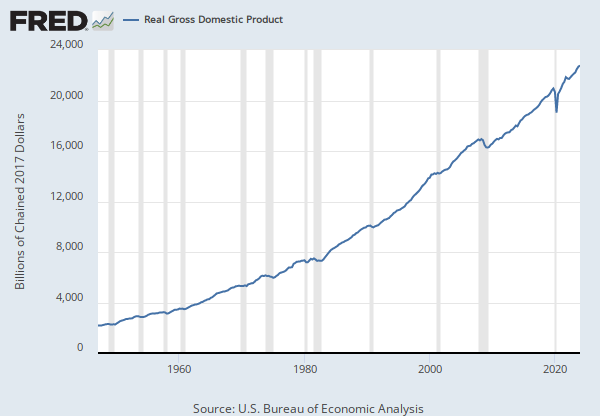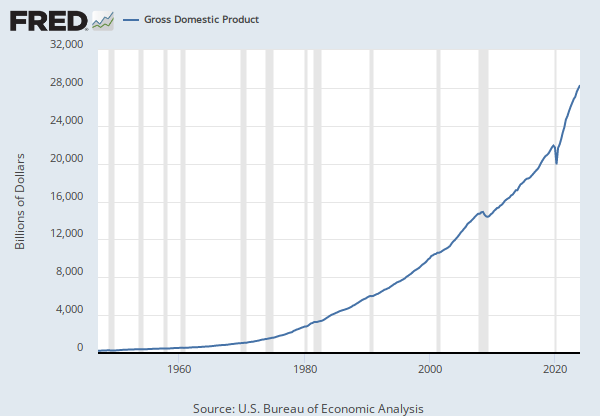FRED Graph
Write a custom formula to transform one or more series or combine two or more series.
You can begin by adding a series to combine with your existing series.
Now create a custom formula to combine or transform the series.
Need help?
For example, invert an exchange rate by using formula 1/a, where “a” refers to the first FRED data series added to this line. Or calculate the spread between 2 interest rates, a and b, by using the formula a - b.
Use the assigned data series variables (a, b, c, etc.) together with operators (+, -, *, /, ^, etc.), parentheses and constants (1, 1.5, 2, etc.) to create your own formula (e.g., 1/a, a-b, (a+b)/2, (a/(a+b+c))*100). As noted above, you may add other data series to this line before entering a formula.
Finally, you can change the units of your new series.
Add the minimum, maximum, and average calculations of selected lines to the graph
Write a custom formula to transform one or more series or combine two or more series.
You can begin by adding a series to combine with your existing series.
Now create a custom formula to combine or transform the series.
Need help?
For example, invert an exchange rate by using formula 1/a, where “a” refers to the first FRED data series added to this line. Or calculate the spread between 2 interest rates, a and b, by using the formula a - b.
Use the assigned data series variables (a, b, c, etc.) together with operators (+, -, *, /, ^, etc.), parentheses and constants (1, 1.5, 2, etc.) to create your own formula (e.g., 1/a, a-b, (a+b)/2, (a/(a+b+c))*100). As noted above, you may add other data series to this line before entering a formula.
Finally, you can change the units of your new series.
Add the minimum, maximum, and average calculations of selected lines to the graph
Data in this graph are copyrighted. Please review the copyright information in the series notes before sharing.
Notes
Source: U.S. Bureau of Labor Statistics
Release: Employment Situation
Units: Percent, Seasonally Adjusted
Frequency: Monthly
Notes:
The unemployment rate represents the number of unemployed as a percentage of the labor force. Labor force data are restricted to people 16 years of age and older, who currently reside in 1 of the 50 states or the District of Columbia, who do not reside in institutions (e.g., penal and mental facilities, homes for the aged), and who are not on active duty in the Armed Forces.
This rate is also defined as the U-3 measure of labor underutilization.
The series comes from the 'Current Population Survey (Household Survey)'
The source code is: LNS14000000
Suggested Citation:
U.S. Bureau of Labor Statistics, Unemployment Rate [UNRATE], retrieved from FRED, Federal Reserve Bank of St. Louis; https://fred.stlouisfed.org/series/UNRATE, April 11, 2025.
Source: U.S. Bureau of Economic Analysis
Release: Gross Domestic Product
Units: Percent Change from Preceding Period, Seasonally Adjusted Annual Rate
Frequency: Quarterly
Notes:
BEA Account Code: A191RL
Gross domestic product (GDP) is the value of the goods and services produced by the nation's economy less the value of the goods and services used up in production. GDP is also equal to the sum of personal consumption expenditures, gross private domestic investment, net exports of goods and services, and government consumption expenditures and gross investment. Real values are inflation-adjusted estimates—that is, estimates that exclude the effects of price changes.
For more information about this series, please visit the Bureau of Economic Analysis.
Suggested Citation:
U.S. Bureau of Economic Analysis, Real Gross Domestic Product [A191RL1Q225SBEA], retrieved from FRED, Federal Reserve Bank of St. Louis; https://fred.stlouisfed.org/series/A191RL1Q225SBEA, April 11, 2025.
Release Tables
- Monthly, Seasonally Adjusted (population data is not adjusted for seasonal variation; not seasonally adjusted version used)
- Table A-10. Selected unemployment indicators, Seasonally adjusted: Monthly, Unemployment Rates
- Table A-15. Alternative measures of labor underutilization: Monthly, Seasonally Adjusted
- Table 1.1.1. Percent Change From Preceding Period in Real Gross Domestic Product: Quarterly
- Table 1.1.2. Contributions to Percent Change in Real Gross Domestic Product: Quarterly
- Table 1.2.1. Percent Change From Preceding Period in Real Gross Domestic Product by Major Type of Product: Quarterly
- Table 1.2.2. Contributions to Percent Change in Real Gross Domestic Product by Major Type of Product: Quarterly
- Table 1.3.1. Percent Change From Preceding Period in Real Gross Value Added by Sector: Quarterly
- Table 1.4.1. Percent Change From Preceding Period in Real Gross Domestic Product, Real Gross Domestic Purchases, and Real Final Sales to Domestic Purchasers: Quarterly
- Table 1.5.1. Percent Change From Preceding Period in Real Gross Domestic Product, Expanded Detail: Quarterly
- Table 1.5.2. Contributions to Percent Change in Real Gross Domestic Product, Expanded Detail: Quarterly
- Table 1.7.1. Percent Change from Preceding Period in Real Gross Domestic Product, Real Gross National Product, and Real Net National Product: Quarterly
- Table 1.8.3. Command-Basis Real Gross Domestic Product and Gross National Product, Quantity Indexes: Quarterly
- Table 1.17.1. Percent Change From Preceding Period in Real Gross Domestic Product, Real Gross Domestic Income, and Other Major NIPA Aggregates: Quarterly
Related Data and Content
Data Suggestions Based On Your Search
Content Suggestions
Other Formats
Unemployment Rate
Monthly, Not Seasonally AdjustedReal Gross Domestic Product
Billions of Chained 2017 Dollars, Annual, Not Seasonally Adjusted Billions of Chained 2017 Dollars, Quarterly, Not Seasonally Adjusted Billions of Chained 2017 Dollars, Quarterly, Seasonally Adjusted Annual Rate Index 2017=100, Quarterly, Not Seasonally Adjusted Annual, Not Seasonally Adjusted Percent Change from Quarter One Year Ago, Quarterly, Not Seasonally Adjusted Percent Change from Quarter One Year Ago, Quarterly, Seasonally AdjustedRelated Categories
Releases
Tags
Permalink/Embed
modal open, choose link customization options
Select automatic updates to the data or a static time frame. All data are subject to revision.




























